One of the first things you notice when you walk into Jonathan Williams’ modest office aboard the Battleship Iowa Museum is a large frame holding a certificate that reads in decorative lettering: Distinguished Public Service Award. It’s the Navy’s highest honor for non-military civilians. It’s also something he and Tom Hanks now have in common.
“I don’t think it’s actually registered with me yet,” says Williams, president and CEO of the Pacific Battleship Center and president of the L.A. Fleet Week Foundation, who was presented with the honor in January during the Surface Navy Association’s 34th National Symposium in Arlington, Va.
The award is the culmination of more than two decades of hard work and dedication in bringing the Battleship Iowa Museum to San Pedro. It’s also an acknowledgment of his leadership with L.A. Fleet Week, which moved to Memorial Day Weekend this year, and the new Surface Navy Museum onboard the Iowa, opening in 2025.
“[I’ve worked with] amazing teams over the years, amazing people that made this happen,” he says. “[The award] is recognition of the work that we’ve done together with the port, the PBID, the chamber, and the USO. It recognizes the work that we’ve all done to raise awareness on why our sea services are important to our nation.”
The road to this moment hasn’t been easy for Williams. Until a few years ago, the married father of two was suffering from severe obesity, anxiety, and depression. If not for a serious illness that scared him into a complete lifestyle change, Williams might not have been around this year to enjoy the rewards.
FINDING A CONNECTION
Born in Denver, Colo., and raised in Bellevue, Wash., Williams, 47, had a turbulent childhood. His parents divorced when he was five, leaving him feeling disconnected from his family for most of his life.
While the rest of his family worked in the tech industry, Williams discovered that he was more attuned to business early on. He started developing an acumen for entrepreneurship while in high school, which would lead to years of launching, selling, and losing several small businesses.
A heavy person most of his life, Williams was pushing 350 pounds after barely graduating high school and started developing numerous physical and mental health issues, including crippling anxiety and depression, that would only worsen as the years went on.
“I kind of ran away into work because of being disconnected,” he says. “I realized just in the past two or three years that I worked all the time to keep my mind busy. Because when I stopped thinking or slowed down, I’d get taken over by depression and anxiety.”
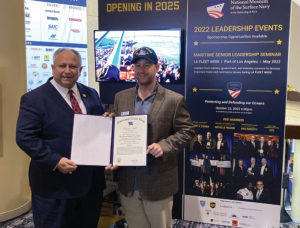
Williams being presented with the Distinguished Public Service Award, the Navy’s highest honor for non-military civilians, by Secretary of the Navy, Carlos Del Toro, in January. (photo: courtesy Jonathan Williams)
Wanting to address this feeling of disconnection with his family, shortly after his maternal grandmother, Ruth Thompson, passed away in 2000, Williams reached out to his grief-stricken grandfather, Ernest Thompson, a retired navy veteran. He simply asked him, “What do you want to do?”
“He said, ‘I want to visit my ship,” recalls Williams. That ship was the USS Missouri, a sister ship to the USS Iowa, which sits as a memorial at Pearl Harbor. Soon, they were on a plane to Hawaii.
As they stepped foot on the retired battleship, Williams watched as a grieving 83-year-old man turned into an 18-year-old sailor before his eyes. “He popped right up, no longer the ailing man,” he recalls. “We see this happen around [the Iowa] all the time.”
Williams would soon accompany his grandfather to his WWII association reunions for the Missouri and USS Tennessee, which his grandfather also served on when stationed in San Pedro. Something about these trips touched a nerve with Williams. He quickly developed an affection for the veterans he’d met and the sense of community they created.
“After going on my grandfather’s ship, I fell in love with his story and who he was. And then by that point, I hear the USS Iowa is moving to the Bay Area to be put in reserve status [for donation].”
A LIFE LESS ORDINARY
In the early 2000s, the USS Iowa and Williams were stuck in the Bay Area. Both were in dire need of repair.
“At the time, I was building a dotcom, then the dotcom bust hit,” recalls Williams. “I was like, ‘I need to do something. I need to volunteer to give back to the community.’ Because it’s one thing to be a profit-mongering, greedy business guy. But you do need something that kind of offsets you to some extent.”
Volunteering to help convert the USS Iowa into a museum seemed like the perfect project. Soon, Williams was operating outreach booths at local farmers markets, speaking to politicians and community groups, and giving tours of the National Defense Reserve Fleet (the “Mothball Fleet”) in Suisun Bay, where the Iowa was temporarily parked.
“[I knew] nothing about nonprofits and raising money or how big of a task this really was,” says Williams. “You start to learn government in a whole different light.”
Williams’ next few years would be a whirlwind of ups and downs. In 2003, he met his soon-to-be wife, Shelley. They got married, bought a house in California’s Central Valley, and, in 2006, welcomed their first son. That same year, he sold his successful janitorial company because the anxiety of owning it was too much to handle. In 2007, he resigned from all Iowa activities for nearly two years because “I didn’t get along with those people [at the time],” he says.
By 2009, Williams had a new construction business and was back volunteering for the Iowa, but his life was in turmoil. The housing crash hit him on both ends. The sudden lack of construction jobs caused his business to suffer, forcing him and his family to move to a more affordable home. He was on the verge of losing his business completely when a lucrative, last-minute construction job came in and saved it.
“I’ll never forget barely having money at that point,” recalls Williams. “I was eating ravioli out of the can, working 18-hour days. I’ll never forget telling my wife [who was thankfully still employed by her family’s business], ‘I’ll be home eventually. Just take care of the kid, don’t worry about me.’ I came back six weeks later, and I rebuilt my business.”
Meanwhile, by 2010, the Bay Area groups had withdrawn their Iowa applications, leaving Los Angeles as the front-runner. “Los Angeles came into play because we needed a port with deep enough water and a birth. We didn’t want to dredge,” says Williams. “When you start looking up and down the coast, there are only very few places you could pull that off.”
In 2011, with the help of a committed group of volunteers led by then-President Robert Kent, the newly formed Pacific Battleship Center in San Pedro was awarded the USS Iowa. The same year, Williams and his wife had their second son.
After a short stint in Richmond, Calif., for external repairs, the Iowa made its way down the California coast, arriving in San Pedro in June 2012. It would celebrate its grand opening a month later, on the Fourth of July.
“[I remember] standing on the starboard side in April 2012, and my business partner called me, and he says, ‘Hey, are you ever coming back to work?’” recalls Williams. “I looked at the ship, and I said, ‘No, I’m not. I love what I do here. I love being here. I’m not coming back. Take most of my salary and go hire somebody.”
After volunteering for the battleship for more than a decade, Williams says he finally began earning a paycheck in 2012. He soon became a familiar fixture in San Pedro, advocating for the museum and joining various committees and boards, including the San Pedro Chamber of Commerce and the Business Improvement District.
“Jonathan and I have had so many opportunities to work together over many years in our roles at the Iowa, AltaSea, the San Pedro Chamber, PBID, Fleet Week, and others,” says Tim McOsker, former CEO of AltaSea and current candidate for L.A. City Council. “He is a tremendous leader, a tireless advocate for our region, and a terrific partner on every project in town.”
SCARED STRAIGHT
Five years ago, Williams fell seriously ill. His blood sugar became unstable, and he thought he would die. This was his wake-up call. “When I got out of that, I decided it was time to do something,” he says. “So, I started walking. I’d go up to Friendship Park and walk. I [found] mental health peace, as well.”
Walking led to joining the YMCA to exercise, which led him to study nutrition and its effects on his body. There was no surgery, just a determination to get healthy. When the Iowa first arrived in San Pedro, he was 365 pounds. Today, Williams weighs in at just over 200. He still struggles with anxiety, but it’s become manageable, and he even reversed his diabetes.
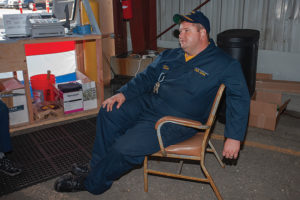
Williams in 2011. (photo: courtesy Jonathan Williams)
But just as he started getting his personal life in order, the pandemic shut the museum down, and suddenly its fate was in question. “We had enough money to last about six weeks,” admits Williams.
The pandemic forced the museum to completely restructure its business model, adding a new ticket system, restructuring tours with add-ons, and opening Vicky’s Doghouse, a new outdoor restaurant and caterer. They also invested more than $60,000 to turn the battleship into a modern events venue, using funds from a Shuttered Venue Operators Grant and private donations, including one for half a million dollars.
“Now we’re generating revenue. We invested in the right places,” says Williams. “We changed our entire strategic vision, rebuilt it, and ended up leaving the pandemic in the best financial shape we’ve ever been in.”
Since arriving in San Pedro ten years ago, Williams has split his time between here and his home in the Central Valley, where his wife and kids reside. He stays in town during the week and goes home most weekends. According to Williams, his wife helps run her family’s business there, “so it was just easier to be a super commuter.”
Today, the Battleship Iowa Museum employs more than 60 people, almost evenly divided between full and part-time, and is ranked the number five museum in L.A. on Trip Advisor. They’re also served by more than 2,000 volunteers, with 300 active every month. With the arrival of West Harbor in a couple of years, the battleship has tentative plans to move to the outer harbor as part of the development.
Looking back on two decades with the battleship, Williams can’t help but feel gratitude. Not only for those who have been a part of his journey but also for still being around to enjoy it.
“Everything in my life, especially the last 20 years, has been absolutely magical,” he says. “I always knew [I worked with] an amazing group of people, but I never really had this deep sense of appreciation for them [until now]. I really do love all of them. I love everybody I work for or with. I deeply care about them. I probably have a deeper appreciation for people now than I ever have in my life.” spt
For more info on the Battleship Iowa Museum, visit pacificbattleship.com.

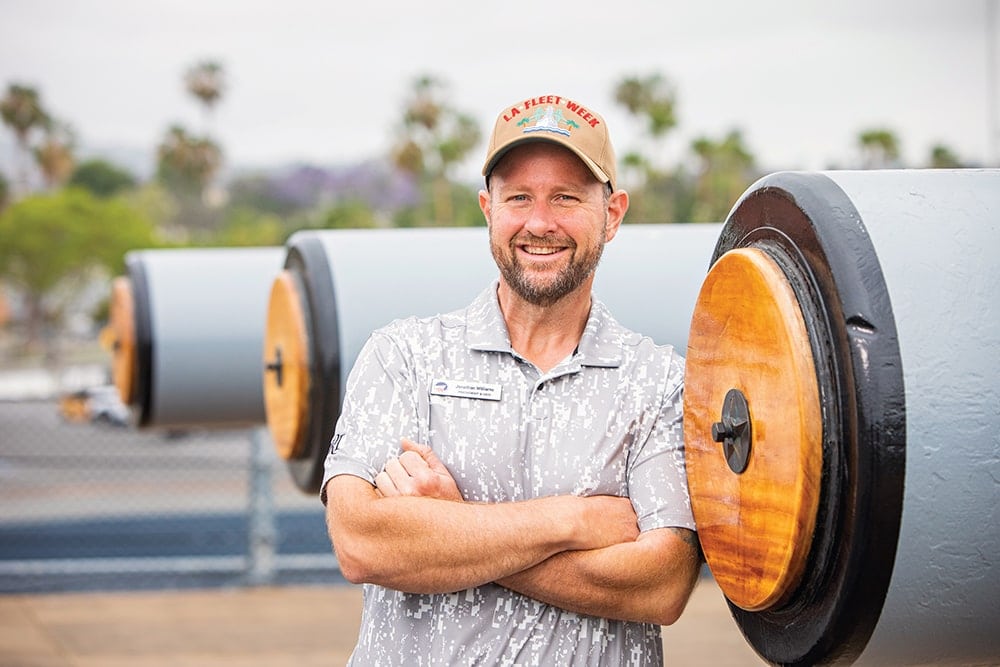

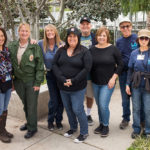
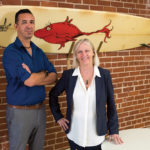
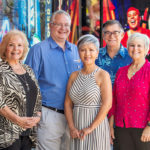
Comments